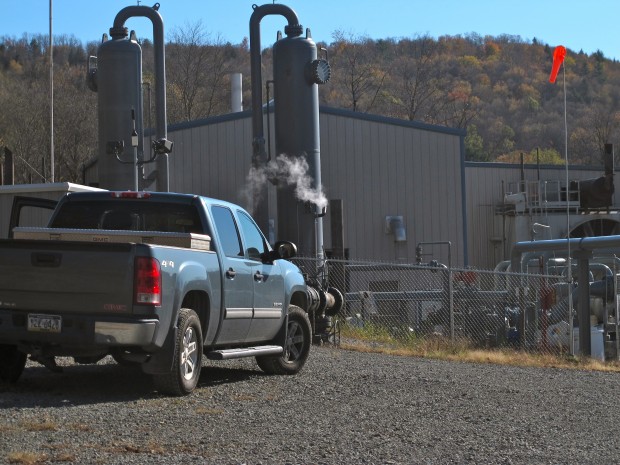Air pollutants from Pa. oil and gas sites continue to rise
-
Susan Phillips

Katie Colaneri/StateImpact Pennsylvania
A compressor station pumps natural gas into the Tennessee Pipeline in Dimock, Pa.
Air pollutants from Pennsylvania’s natural gas production sites increased from 2013 to 2014, according to data released Wednesday by the Department of Environmental Protection. The air inventory data for shale gas production relies on information submitted by the industry, and includes emissions from compressor stations that utilize gas from coal beds, conventional, and unconventional wells. Although the number of well sites reporting information to the DEP dropped by 2.7 percent from 2013 to 2014, the number of pipeline related infrastructure sites increased by 12 percent.
Sulfur dioxide emissions saw the greatest jump, increasing 40 percent over 2013 levels. Sulfur dioxide contributes to acid rain, and causes respiratory problems including asthma. Other air pollutants that contribute to public health impacts also increased, including nitrogen oxides, particulate matter, sulfur dioxide, and volatile organic compounds.
Acting DEP secretary Patrick McDonnell said that despite a growth in production, he’s optimistic air pollution from these sites can be reduced.
“As pipeline infrastructure and natural gas production continues to grow in Pennsylvania, it is increasingly important that we ensure that natural gas stays in those pipelines and other facilities and isn’t leaking into our communities,” McDonnell said in a release. “With universal adoption of best practices that many companies are already using, we expect leaks to go down even as production goes up.”
Critics of the inventory data say the figures are inaccurate due to outdated calculation methods and a lack of verification. Recent studies that used fly-overs to measure methane for example, show a gap between the data collected directly from the source, and the data calculated by industry for these types of inventories.
The 2014 shale gas emissions inventories include increases of 18 percent for nitrogen oxides, 25 percent for both fine particulate matter and volatile organic compounds (VOC’s), and 19 percent for carbon monoxide. Particulate matter causes heart attacks, asthma, and difficulty breathing. It can be fatal for people with heart and lung disease. VOC’s cause a number of symptoms including eye, nose and throat irritations; headaches, nausea, as well as liver and kidney damage.
An epidemiological study conducted by the Johns Hopkins School of Public Health and recently published in JAMA, using medical records from the Geisinger Health System, found that people with asthma face a larger risk of asthma attacks if they live near heavy gas drilling activity in Pennsylvania, compared to those who don’t.
Although methane and carbon monoxide emissions had decreased in the 2013 inventory, for 2014 those pollutants were up by 19 percent for carbon monoxide, and 1 percent for methane, a potent greenhouse gas. The Wolf administration announced new measures to control methane emissions in January but they have not yet been enacted.
McDonnell says overall the state’s air quality is improving, despite the increased emissions from the natural gas sector because emissions from other sources are decreasing, including power plants that have switched from coal to natural gas.
The Clean Air Council’s Matt Walker says inventory data is not reliable and likely underestimates the pollution. It is not measured with instruments, but is based on engineering calculations.
“Even the best self-reporting is not adequate because the formulas are out of date,” Walker said. “Nobody knows how much the oil and gas industry is emitting in Pennsylvania. Nobody.”
The DEP did conduct an air quality study in southwestern Pennsylvania that used actual instrumentation to measure emissions. DEP spokesman Neil Shader says the report is now being reviewed by the Pennsylvania Department of Health and the federal Agency for Toxic Substance and Disease Registry. Shader says he expects that study to be released this fall.
DEP only began collecting this air inventory data from shale gas producers in 2011. A year later, pipeline operators were required to report emissions data from compressor stations. The agency then expanded their required emissions reporting in 2013 to operators of compressor stations that transport coal-bed methane.
In addition to well sites and compressor stations, industry reports data from dehydration units, pump seals and valves, heaters, pneumatic controllers and pumps, engines, tanks, pressurized vessels and impoundments, and venting and blow down systems.
















